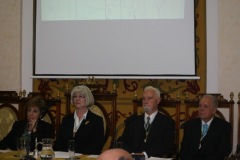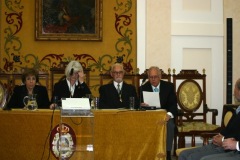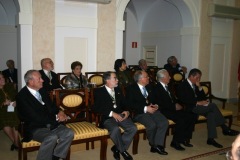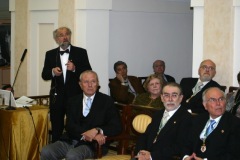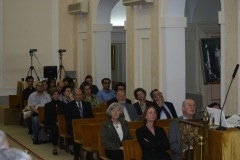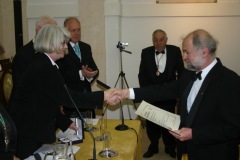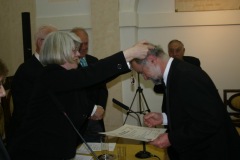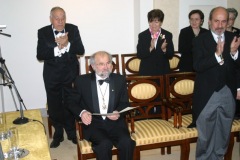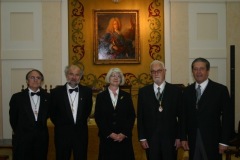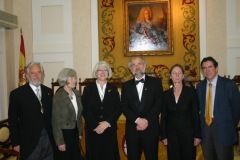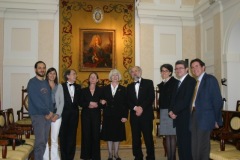Toma de Posesión como Académico de Honor del Premio Nobel Erwin Neher
 It is an extraordinary distinction to accept the honorary membership of the Real Academia Nacional de Farmacia. I feel particularly priviliged about this move – since my training and main scientific efforts are not in pharmacology, but in electrophysiology and biophysics of membranes. This is why I dedicate this lecture to the interface between pharmacology and my field, trying to convey to you my perception of some of the major advances in pharmacology during the last 40 years. This view necessarily is biased towards functional aspects, in particular those, which I was lucky to be able to contribute. Let me make it clear that this is only a small fraction of advances that have been made in this period, particularly with approaches of molecular biology and genetics. Phase I: Otto Loewi’s ‘Vagusstoff’ In the 1970s my interest was in ion channels. Originally concerned with voltage-dependent ion channels (a physicist’s preoccupation) my attention got redirected towards Acetylcholine-activated channels at the frog neuromuscular junction. Bert Sakmann convinced me that these are the type of ion channels, which are most likely to yield to single-channel recording. The concept of ‘ion channels’ had not yet been proven. Questions such as whether they existed and, if so, what their current signals are like, were typical issues at that time. So, we made an effort to refine electrophysiological recording methods with the goal to record current signals reflecting the opening and closing of single ion channels. The result was the ‘patch clamp technique’, in which a measuring pipette is pressed against a cell surface trying to collect currents, which flow through channels within the ‘patch’ of membrane, (the area covered by the pipette). In 1976 we published the first such recordings. They clearly showed that currents change in a step-like manner, when channels are activated by Acetylcholine and that the duration of such episodes of current flow is a stochastic variable – as expected from a single-molecule reaction (Neher and Sakmann, 1976). The recording method at that time was rather primitive. A limiting factor for the resolution of the method is the tightness of the seal between recording pipette and membrane – in other words, the ability of the pipette to prevent currents to escape being guided to the amplifier. For many years all our efforts to improve the seal were without success. Nevertheless, we managed (at moderate resolution) to characterize activation of nicotinic channels by various cholinergic agonists (Neher & Sakmann, 1976; Sakmann et al.,1980) and to demonstrate transient block of open channels by local anesthetics (Neher and Steinbach, 1978).
It is an extraordinary distinction to accept the honorary membership of the Real Academia Nacional de Farmacia. I feel particularly priviliged about this move – since my training and main scientific efforts are not in pharmacology, but in electrophysiology and biophysics of membranes. This is why I dedicate this lecture to the interface between pharmacology and my field, trying to convey to you my perception of some of the major advances in pharmacology during the last 40 years. This view necessarily is biased towards functional aspects, in particular those, which I was lucky to be able to contribute. Let me make it clear that this is only a small fraction of advances that have been made in this period, particularly with approaches of molecular biology and genetics. Phase I: Otto Loewi’s ‘Vagusstoff’ In the 1970s my interest was in ion channels. Originally concerned with voltage-dependent ion channels (a physicist’s preoccupation) my attention got redirected towards Acetylcholine-activated channels at the frog neuromuscular junction. Bert Sakmann convinced me that these are the type of ion channels, which are most likely to yield to single-channel recording. The concept of ‘ion channels’ had not yet been proven. Questions such as whether they existed and, if so, what their current signals are like, were typical issues at that time. So, we made an effort to refine electrophysiological recording methods with the goal to record current signals reflecting the opening and closing of single ion channels. The result was the ‘patch clamp technique’, in which a measuring pipette is pressed against a cell surface trying to collect currents, which flow through channels within the ‘patch’ of membrane, (the area covered by the pipette). In 1976 we published the first such recordings. They clearly showed that currents change in a step-like manner, when channels are activated by Acetylcholine and that the duration of such episodes of current flow is a stochastic variable – as expected from a single-molecule reaction (Neher and Sakmann, 1976). The recording method at that time was rather primitive. A limiting factor for the resolution of the method is the tightness of the seal between recording pipette and membrane – in other words, the ability of the pipette to prevent currents to escape being guided to the amplifier. For many years all our efforts to improve the seal were without success. Nevertheless, we managed (at moderate resolution) to characterize activation of nicotinic channels by various cholinergic agonists (Neher & Sakmann, 1976; Sakmann et al.,1980) and to demonstrate transient block of open channels by local anesthetics (Neher and Steinbach, 1978).
Intervenciones
Juan Tamargo Menéndez
Académico de Número de la RANF
Erwin Neher

